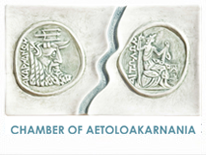|
The unique beauty, protected by the Ramsar Convention wetland of “Messolonghi – Aetoliko” Lagoon, is also famous for its fine fish. The eels, the mullet, the sea bass and the sea bream of Messolonghi, remaining in the shallows and with excellent composition and flora of the lagoon, acquire a special taste and flavor. When pickled they acquire greater value. The seeds are mainly pasted, but also sea bream, some species of cephaloids and eels. Especially salted seeds are of renowned gastronomic value. Pickling takes place mainly in winter, where the fish are thicker and nourished. The procedure is as follows: The fish are cleaned from the scales, washed and salted externally and internally. Then they are placed in baskets or deep buckets, one on top of the other. Every two - three days they are moved ("turned") and after 10 - 12 days, they come out of the basket, are washed and hung upside down. After draining and drying, the skin is removed by abrasion and eaten raw (plain) or with lemon oil.
Fish paste can be stored for up to 40 days. The eels more. These are not eaten raw. You have to bake them. The seeds are salted in less time. They can be eaten three days after salting. But they last only 15 days. They are also eaten raw. Salted fish or “alipasta” under their brand name, are fish that are placed in a layer of salt for their preservation. The ancient Greeks really liked the salted fish which they called "tarichi". Good quality " tarichi " were very expensive, they were a sign of prosperity and for this reason those who tasted them, were considered to have refined taste. Fish Salting Fish Salting is considered one of the oldest methods of preservation. This process requires some preconditions. In order to achieve the right fish salting, some procedures must be followed which are influenced by some components. These are the weather conditions, the quality of the salt, the type of fish and finally the size of the fish. So, we conclude that the fish salting process is an art that we learn over the years and with a lot of practice. It is good when someone starts fish salting, to start with small fish, to learn how much time is required for the whole process.
The process before salting The fish should be fresh. If the fish is larger than a kilo, we must be careful to remove the blood properly because it will smell bad. This is done with an incision under the right flap. If this procedure has not been done, then we should leave the fish in ice water for 4 hours until all the blood is gone.
The Fish Salting Process After completing the procedures before salting, continue with the Fish Salting. Here we have two ways which are determined mainly by the weight of each fish. So, if a fish is less than a kilo, we can open it in the middle. We start by cutting it from the bottom and taking care that the two fillets remain connected to the back. Then we remove the bones and we put it in salt for 2 days. After 2 days, we remove the salt, we rinse it, we put it in a pan, add sunflower oil and we keep it in the refrigerator. When the fish is bigger than a kilo, we follow the brine process. In this way the fish is cut into thick slices and placed inside it.
For the brine We make a brine with 1.5 liters of water and two tablespoons of coarse salt. If we want to make sure that the salt is enough, we dip an egg in it. If the egg rises to the surface, then the amount of salt is right. After placing the pieces of fish in the brine, we leave it for 3 to 4 days, renewing the brine daily. After 4 days, we remove the pieces of fish from the brine, we drain them and place them in coarse salt (on both sides). We place the pieces in a colander with a pan underneath and put them in the fridge for 2-3 days. Then we rinse the salt from the pieces, we dry them and place them in glass jars with sunflower oil. We place them in the refrigerator to preserve for 20 to 30 days. It is served plain with olive oil or with the addition of a spice of our choice. THE PETALS The petals are made of sea bream, mullets and eels as follows: They open them in the middle from the back to the abdomen and from the head to the tail. Both parts are held by the abdomen. Then they are salted, they left for 3-4 hours in the salt and then washed. The two parts are kept stretched with a reed slit and dried in the shade.
THE EELS Messolonghi Lagoon is an ideal habitat for many species of eels (Anquilla). Especially the eels of Messolonghi are considered one of the most delicious in Europe and are a very popular dish. The eels are shaped with a variety of lengths and weights and the best known in Messolonghi are Souvlomytari, Kavatsa, Vitselouro, Katharohelo and Droggos. The eels are eaten boiled or grilled, on a spit or in the oven and are rarely salted. People from Messolonghi also make delicious petals. Most of the local production is exported to Italy. The petals are kept for a maximum of two - three days and eaten half-cooked, when the petals are dry are eaten raw. |
AETOLEAN PRODUCTS











